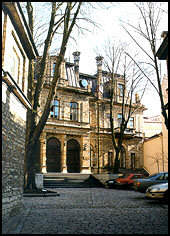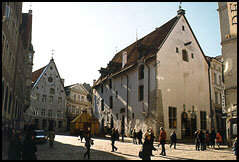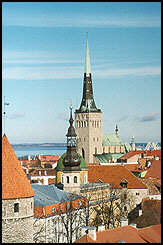 Geography Geography |
 Geology and Topology Geology and Topology |

Estonia is a generally low and flat country with low elevations that rarely exceed 100 meters above sea level. The average altitude of the land surface is about 50 meters. Suur Munamägi (Hill) in the south-eastern corner, reaches 318 meters above sea level, being the highest point not only in Estonia, but in all of the three Baltic countries. The lowest part of the country is in the west, including the western offshore islands. The slightly undulating topography of Estonia is characterized by the alternation of low highlands and low plateaus with lowlands, depressions and vales, diversified by minor landforms. The main highlands are to be found in the northern and southern parts: Pandivere (up to 166 m above sea level), Sakala (146 m), Otepää (217 m), Karula (137 m), and Haanja (318 m) highlands.
An in-depth analysis of the Estonian underground would show that Estonia is actually fairly old. Digging deep enough, one would fine a rock layer dating from the very early days of our planet. Actually, this layer appears only in Finland and Sweden, and on some islands in the Gulf of Finland. In Estonia these rocks, e.g. granite, gneiss, etc., are covered by a layer of more recent rocks, particularly limestone, sandstone, and clay, which were formed 350-600 million years ago. The limestone in northern Estonia contains the most important mineral resources: oil shale or kukersite (reserves estimated at 6,000 million metric t), considered to be the best in the world, and phosphorite (700 million metric t). By the way, limestone was named the national rock of Estonia some years ago.
However, the geological period which is of immediate interest to us, is of much more recent date. We have to go back to the Ice Age, which stretched from at least 550,000 to about 10,000 BC, to establish the origins of the Estonian landscape as we know it today.
Scientists claim that the ice masses of the far North rolled over what is now Estonia at least four times. Each time the ice left huge quantities of earth, sand and stone - called moraine. Ice masses moved across the territory, breaking and pulverizing the dislodged pieces, rounding the hills and forming plenty of glacial landforms. Among them, a number of long narrow swells of gravel and sand (extensive flat or hilly areas of sand and gravel), and a few moraine ridges mark what was once the glacier's edge. The central part of Estonia abounds with drumlins - the peculiar elongated hills or ridges of moraine, usually oval and shaped like half an egg. In southern Estonia, hummocky topography, made up of irregular hills and hollows in the moraine, is spread through several localities.
 |
The ice left its marks on the Estonian landscape in other ways, as well. It brought to the country so-called erratic boulders - huge lumps of Finnish rocks. The melted water also had a great impact on the landscape. Streaming beneath the ice and along its borders, it dug deep valleys in the soil, and transported a lot of clay and sand with it. This sand and clay was deposited in the lowland basins, which were filled by icedammed lakes. As a rule, a great part of there lowland areas has turned into peatlands.
The sea by Estonia, too, played an active part, working upon the country during the course of the millennia. Shortly after the last Ice Age, about 8,000 to 10,000 years ago, result of the steady uplift of the surface during the ensuing ages. This rising of land still continues and is at its strongest in the northwestern part of the country, where it exceeds 25 cm per hundred years. In fact, only very recently (from a geologist's viewpoint!) has Estonia achieved its present form. For example, less than one thousand years ago, seamen could sail directly to what we know now as the center of Tallinn.
 Climate Climate |
Estonia has a moderately cool and moist temperate climate. The lowest temperature (-43.5oC) was measured in January, 1941. Severe frosts of thirty or more degrees below zero are not particularly frequent and are mainly confined to the interior of the country. In the coastal regions the temperature rarely drops below -25oC. The highest recorded temperature is 35oC. On average, however, Estonia doesn't have fluctuations of temperature of more than 20 to 25oC in the course of one year. Normally, i.e. an average of temperature measured over a hundred-year period, they range from 16.3 (in the Western Archipelago) to 17.1oC (in the interior) in the warmest month, July, and -3.5 (in the Western Archipelago) to -7.6oC (in the interior) in the coldest, February.

Annual precipitation fluctuates between 50 cm in the Western Archipelago and more than 75 cm on some uplands. Due to the highly changeable weather, prolonged droughts are by no means rare during late spring and early summer in some years, while other years can be relatively rainy. Estonians experience normally about 150 to 200 rainy days in a year. Precipitation is heaviest at the end of summer, and lowest in the spring.
Frost occurs about 100 days a year, and according to statistics, snow cover forms usually at the beginning of December and lasts until the end of March. Deepest snow (over 50 cm) is on the highlands of southeastern Estonia. On the other hand, in exceptionally mild winters, there is no perpetual snow cover at all.
In Estonia, southwestern and western winds prevail. Whirlwinds and heavy storms are rare. The last strong "storm of the century", which devastated great expanses of woods, raged in western Estonia in the autumn of 1967. |

